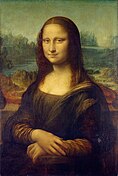| History of art |
|---|
The history of art focuses on objects made by humans for any number of spiritual, narrative, philosophical, symbolic, conceptual, documentary, decorative, and even functional and other purposes, but with a primary emphasis on its aesthetic visual form. Visual art can be classified in diverse ways, such as separating fine arts from applied arts; inclusively focusing on human creativity; or focusing on different media such as architecture, sculpture, painting, film, photography, and graphic arts. In recent years, technological advances have led to video art, computer art, performance art, animation, television, and videogames.
The history of art is often told as a chronology of masterpieces created during each civilization. It can thus be framed as a story of high culture, epitomized by the Wonders of the World. On the other hand, vernacular art expressions can also be integrated into art historical narratives, referred to as folk arts or craft. The more closely that an art historian engages with these latter forms of low culture, the more likely it is that they will identify their work as examining visual culture or material culture, or as contributing to fields related to art history, such as anthropology or archaeology. In the latter cases, art objects may be referred to as archeological artifacts.





